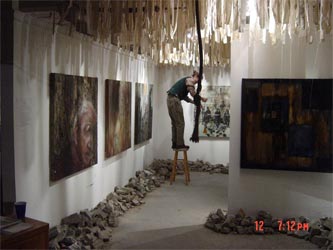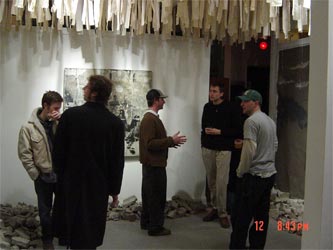I�m interested in the spatio-temporal aspects of after. What happens.
After the war. After the destruction, the rubble that is left. The perception of after in the minds of those in the midst of destruction.
What happens after a painting is constructed? After it has been made, shown, sold, and sitting in someone�s basement for years? Its relationship to its surroundings is never static. What is the effect of the passage of many years?
In my mind, this passage of time and its harsh (but often glacial) effects on people, landscapes and paintings are best evoked in layers; layers of paint, plaster, tar, dust and rubble that have been worn away to varying degrees, perhaps by chance, perhaps as a result of proximity to the forces that wear. This interest in layers and degradation down through layers has roots in my earlier biological studies of the decay of organic matter. Detritus on the forest floor lies in strata that are more broken down by micro-organisms the farther down one digs. The process by which humus accumulates season by season, and is either covered entirely by new layers or uncovered by unfolding events interests me greatly, as I strive in my painting process to lay down layers upon layers of media that may or may not become uncovered later.
What (or who) is lost, and what (or who) is left behind? The questions drive my painting experiments, as well as the subject matter in these eight paintings, seven of which contain figures which seem to have been left behind, or are on their way to disappearing.
 |
Drew helping with final touches on the installation |
 |
During the opening |
More of Lydia's work.

